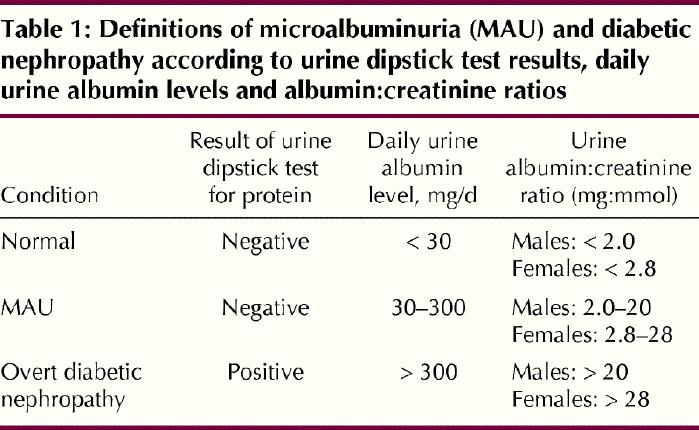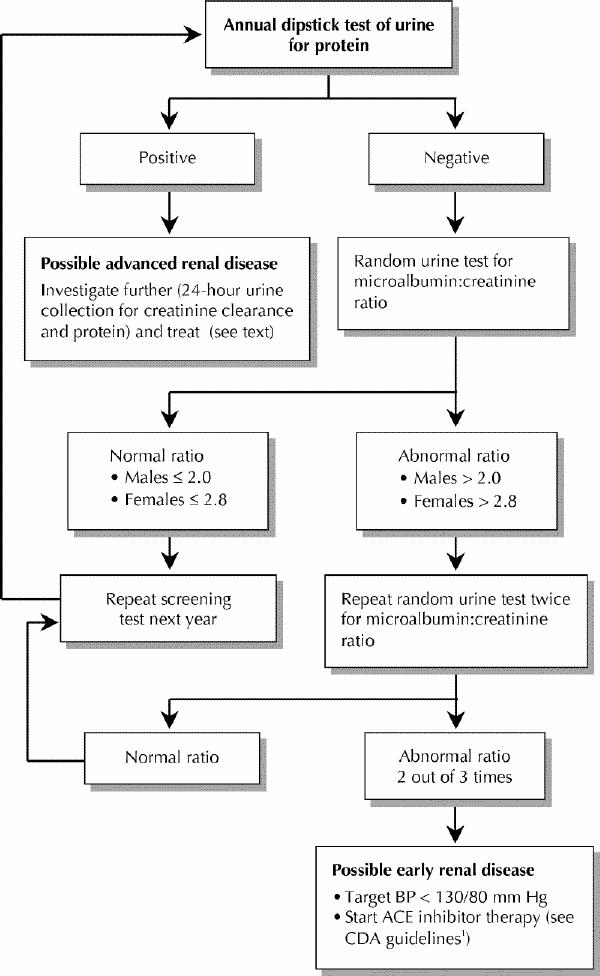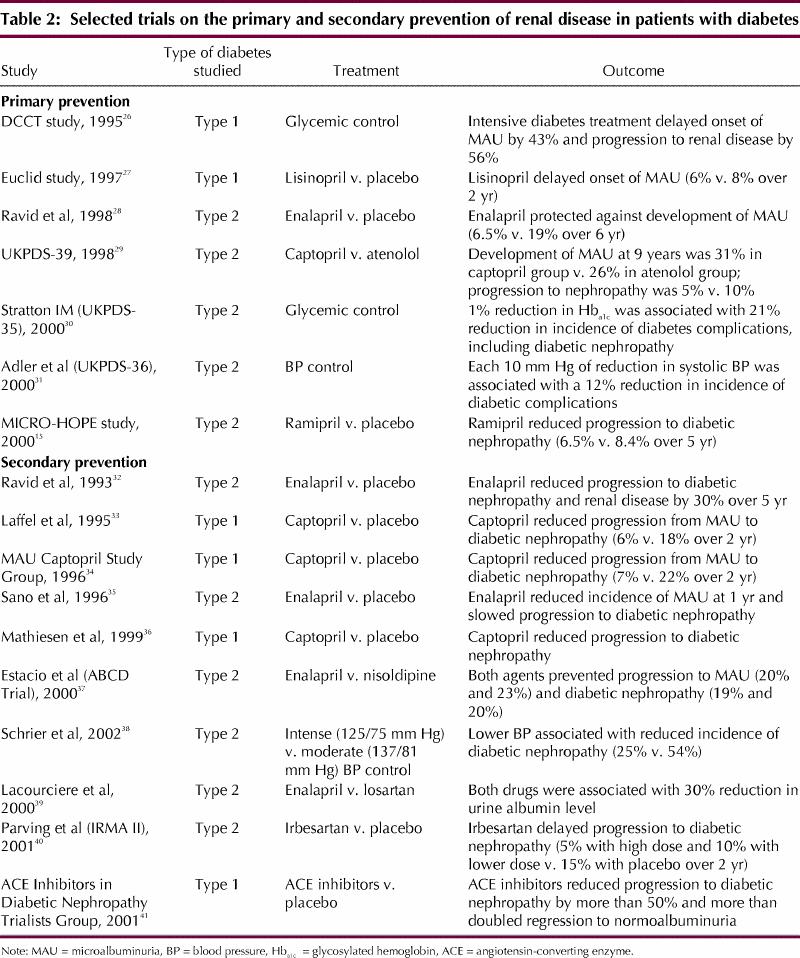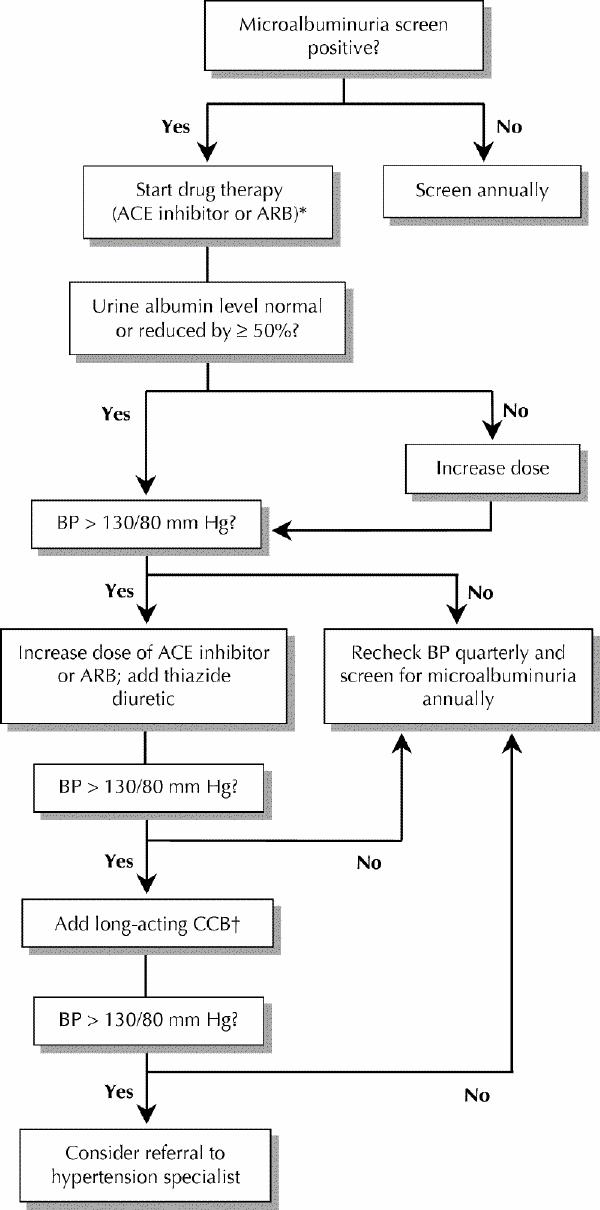Case
A 50-year-old woman with type 2 diabetes mellitus identified 5 years earlier presents for an annual physical examination. She has no history of hypertension and is not known to have had a previous cardiovascular event. She visits the ophthalmologist annually. Her medications include an over-the-counter multivitamin, an oral hypoglycemic agent and a statin for known hypercholesterolemia. She is otherwise well, and the findings on physical examination are unremarkable. Her physician is aware of recent Canadian Diabetes Association guidelines advising microalbuminuria screening for diabetic patients. Should the woman be screened for microalbuminuria on this visit? What is the best way to screen for it? If the test result is positive, what does this mean in terms of the patient's risk for cardiovascular and renal disease? Is there anything that can be done medically for microalbuminuria? What follow-up is required, including management of other risk factors?
The incidence of diabetes mellitus in North America is reaching epidemic proportions and is expected to double by 2025.1 Over 5% of the population is known to have diabetes, and as many as another 2.5% are estimated to have the disease without knowing it.2 The prevalence of diabetes is increasing faster in the First Nations population than in the general population, and the onset is occurring at ever earlier ages.3 Diabetes is the most common cause of end-stage renal disease (ESRD) in Canada and is a major risk factor for cardiovascular disease and blindness.4
Microalbuminuria represents an abnormally elevated urine albumin level that cannot be detected with the use of a urinalysis dipstick. The presence of microalbuminuria predicts worsening of renal disease to overt diabetic nephropathy5 and an elevated risk of cardiovascular disease.6,7,8,9 Up to 30% of people with newly diagnosed type 2 diabetes will already have abnormally high urine albumin levels; about 75% of these people will have microalbuminuria and about 25% will have overt diabetic nephropathy.10,11,12,13,14 Patients with type 2 diabetes who were enrolled in the MICRO-HOPE study, for example, had a risk of progression from normal to diabetic nephropathy of 2% and a risk of progression from microalbuminuria to diabetic nephropathy of 20% over 5 years.15 These rates are similar for type 1 and type 2 diabetes.16,17,18,19,20,21
Early detection of microalbuminuria through screening allows interventions aimed at preventing diabetic nephropathy. In this article we review strategies for microalbuminuria screening in diabetic patients and for introducing therapies to prevent the progression of renal disease.
Diagnosis
Patients with diabetes are at risk of microalbuminuria if they have any of the following factors:
· the urine albumin excretion is in the upper range of normal (20–30 mg/d);
· the systolic blood pressure is greater than 130 mm Hg;
· the glycosylated hemoglobin level is greater than 0.09; or
· the total cholesterol level is greater than 5.24 mmol/L.
Several methods for screening for microalbuminuria are available, including timed urine collections (over 24 hours or overnight) to measure protein levels and random urine tests using laboratory tests, dipsticks or special devices (e.g., automated urine analyzers) to measure microalbumin levels or to calculate the microalbumin:creatinine ratio (MACR). Regular urinalysis dipsticks are not sensitive enough to detect early microalbuminuria.
Microalbuminuria is diagnosed when the urine albumin level is 30 mg/d or greater (Table 1). This can be expressed either as a quantity of albumin excreted per time (> 20 μg/min) or as a concentration (> 20 mg/L urine). The Canadian Diabetes Association recommends the calculation of the MACR from a random urine sample (Fig. 1).1 The MACR is preferable to a simple measure of albumin excreted in urine because the latter can be distorted by the effects of urine concentration. The MACR is more convenient to perform than a 24-hour urine collection, and the results of these 2 tests have been shown to correlate highly.22 Given that there is significant variability in the daily amount of albumin excreted in urine, the Canadian Diabetes Association recommends that microalbuminuria be diagnosed only if the MACR is abnormal in 2 out of 3 tests.1
Table 1


Fig. 1: Guidelines for screening microalbuminuria in patients with diabetes mellitus. BP = blood pressure, ACE = angiotensin-converting-enzyme, CDA = Canadian Diabetes Association.
Because urine albumin excretion is a continuum, we have indicated ranges that define normal, microalbuminuria and overt diabetic nephropathy (Table 1). Higher albumin excretion within each range is predictive of the risk of progression to the next.23 Worsening of renal disease in people with diabetes is also predicted by the severity of other traditional cardiovascular risk factors, including blood pressure, cholesterol level and blood glucose level.24
Management
Glycemic control can prevent progression to microalbuminuria. Preventing the progression of each step of renal disease in patients with diabetes — microalbuminuria, diabetic nephropathy, and ESRD or death — can be achieved with blood pressure control25 and the use of antiangiotensin therapies such as angiotensin-converting-enzyme (ACE) inhibitors and angiotensin II receptor blockers (Fig. 2, Table 215,26,27,28,29,30,31,32,33,34,35,36,37,38,39,40,41).

Fig. 2: Prevention of progression of renal disease in people with diabetes mellitus. ARB = angiotensin II receptor blocker, ESRD = end-stage renal disease.
Table 2

Primary prevention (preventing microalbuminuria) can be achieved through good glycemic26 and blood pressure control30 and through the use of an ACE inhibitor in both type 1 and type 2 diabetes27,28 (Table 2).
Secondary prevention (preventing the progression from microalbuminuria to diabetic nephropathy) can be achieved with an ACE inhibitor in both type 1 and type 2 diabetes15,32,33,34,35,36 and with an angiotensin II receptor blocker40 in type 2 diabetes (Table 2). In the study by Parving and associates40 antiangiotensin therapy with irbesartan was found to reverse microalbuminuria in up to one-third of patients. Of interest, in that study, the higher dose of irbesartan (300 mg) was significantly more protective than the lower dose (150 mg) against progression from microalbuminuria to diabetic nephropathy (59% v. 10%).
Tertiary prevention (preventing the progression from diabetic nephropathy to ESRD) independent of the blood pressure effect can be achieved with an ACE inhibitor in type 1 diabetes42 and with an angiotensin II receptor blocker in type 2 diabetes.43,44 It is unknown whether ACE inhibitors and angiotensin II receptor blockers are equally effective or whether they are more effective when combined.
Once microalbuminuria is diagnosed in a patient with diabetes, it is time to stress to the patient the need to manage multiple risk factors for cardiovascular disease. The target blood pressure should be below 130/80 mm Hg,45 the target low-density lipoprotein cholesterol level should be below 2.5 mmol/L,46 and smoking cessation should be mandatory.
Fig. 3 outlines a potential algorithm for controlling blood pressure in people with diabetes. Combinations of antihypertensive drugs are often needed to achieve the target blood pressure.48 The algorithm represents an extrapolation from existing evidence; however, evidence concerning the most effective combination or order of medications has not yet been established in trials. Diabetic patients with microalbuminuria should have their blood pressure monitored quarterly and their renal function checked annually, or more often if they have risk factors for vascular disease. If renal function deteriorates, referral to a nephrologist is appropriate.

Fig. 3: Possible algorithm for controlling blood pressure in diabetic patients with microalbuminuria. [This algorithm is based on the opinions and practice of the authors.] CCB = long-acting calcium-channel blocker. *On the basis of results of recent clinical trials, start with an ARB40 or ACE inhibitor.15 †Possible agents to add are a long-acting dihydropyridine CCB44,47 and a β-blocker if necessary; another possibility instead of these agents is a nondihydropyridine CCB, with no β-blocker, particularly if the patient's heart rate is greater than 80 beats/min.48
Case revisited
The patient should have a random urine test to determine the MACR. If the ratio is greater than 2.8 the test should be repeated twice. If the ratio is greater than 2.8 in 2 out of 3 tests, microalbuminuria should be diagnosed and antiangiotensin therapy started with an ACE inhibitor or angiotensin II receptor blocker. Because of the patient's increased risk of cardiovascular and renal disease, her blood pressure and hypercholesterolemia should be closely monitored and managed as necessary.
Comments
Microalbuminuria screening meets the fundamental requirements for a screening test,49 and because it is cost-effective it will help to relieve some of the burden on our health care system. In our view, the Canadian Diabetes Association practice guideline regarding microalbuminuria screening1 is an important contribution to the management of patients with diabetes. In conscientiously applying the guideline, physicians may be able to prevent progressive renal disease, and ultimately renal failure, in many patients with diabetes.
Key points .
Diabetes mellitus is becoming increasingly common.
Microalbuminuria is likely to be found in one-third or more of diabetic patients.
Microalbuminuria is a risk factor for cardiovascular and renal disease.
Antiangiotensin therapy and blood pressure control can reduce urine albumin levels and give renal protection.
All patients with type 2 diabetes should be screened annually for microalbuminuria.
Determine the microalbumin:creatinine ratio from a random urine sample. Microalbuminuria is present if the ratio is abnormal (> 2.0 in men, > 2.8 in women) in 2 out of 3 tests.
Additional resources .
American Diabetes Association: www.diabetes.org
Canadian Diabetes Association: www.diabetes.ca
Canadian Hypertension Society: www.chs.md
National Institutes of Health diabetes site: www.niddk.nih.gov/health/diabetes/diabetes.htm
Drugs in classes referred to in this article .
Angiotensin II receptor blockers: candesartan, eprosartan, irbesartan, losartan, telmisartan, valsartan
Angiotensin-converting-enzyme (ACE) inhibitors: benazepril, captopril, cilazapril, enalapril, fosinopril, lisinopril, perindopril, quinapril, ramipril, trandolapril
Dihydropyridine calcium-channel blockers (CCBs): amlodipine, felodipine, nifedipine
Nondihydropyridine CCBs: diltiazem, verapamil
Thiazide diuretics: hydrochlorothiazide, indapamide
β-Blockers: atenolol, bisoprolol, metoprolol
Footnotes
This article has been peer reviewed.
Contributors: All of the authors contributed substantially to the content of the article, participated in the drafting and revising of the manuscript and approved the final version.
Competing interests: Dr. Tobe has received speaker fees from and has attended meetings sponsored by most of the major pharmaceutical companies. Dr. McFarlane has received speaker fees from Aventis Pharma, Bristol-Myers Squibb and Merck Frosst. Dr. Naimark has received speaker fees from Janssen-Ortho Biotech.
Correspondence to: Dr. Sheldon W. Tobe, Rm. A240, Sunnybrook & Women's College Health Sciences Centre, 2075 Bayview Ave., Toronto ON M4N 3M5; fax 416 480-6940
References
- 1.Meltzer S, Leiter L, Daneman D, Gerstein HC, Lau D, Ludwig S, et al. 1998 clinical practice guidelines for the management of diabetes in Canada. CMAJ 1998;159(8 Suppl):S1-S29. Available: www.cmaj.ca/cgi/content/full/159/8/DC1. [PMC free article] [PubMed]
- 2.Tan MH, MacLean DR. Epidemiology of diabetes mellitus in Canada. Clin Invest Med 1995;18:240-6. [PubMed]
- 3.Young TK, Reading J, Elias B, O'Neil JD. Type 2 diabetes mellitus in Canada's First Nations: status of an epidemic in progress [review]. CMAJ 2000;163:561-6. [PMC free article] [PubMed]
- 4.2000 CORR report — dialysis and renal transplantation, Volume I. Ottawa: Canadian Institute for Health Information; 2001.
- 5.Krolewski AS, Laffel LM, Krolewski M, Quinn M, Warram JH. Glycosylated hemoglobin and the risk of microalbuminuria in patients with insulin-dependent diabetes mellitus. N Engl J Med 1995;332:1251-5. [DOI] [PubMed]
- 6.Eastman RC, Keen H. The impact of cardiovascular disease on people with diabetes: the potential for prevention [review]. Lancet 1997;350(Suppl 1):SI29-32. [DOI] [PubMed]
- 7.Warram JH, Gearin G, Laffel L, Krolewski AS. Effect of duration of type I diabetes on the prevalence of stages of diabetic nephropathy defined by urinary albumin/creatinine ratio. J Am Soc Nephrol 1996;7:930-7. [DOI] [PubMed]
- 8.Nielsen S, Schmitz A, Rehling M, Mogensen CE. The clinical course of renal function in NIDDM patients with normo- and microalbuminuria. J Int Med 1997;241:133-41. [DOI] [PubMed]
- 9.Bennett PH, Haffner S, Kasiske BL, Keane WF, Mogensen CE, Parving HH, et al. Screening and management of microalbuminuria in patients with diabetes mellitus. Recommendations to the Scientific Advisory Board of the National Kidney Foundation from an ad hoc committee of the Council on Diabetes Mellitus of the National Kidney Foundation. Am J Kidney Dis 1995;25:107-12. [DOI] [PubMed]
- 10.Delcourt C, Vauzelle-Kervroedan F, Cathelineau G, Papoz L. Low prevalence of long-term complications in non-insulin-dependent diabetes mellitus in France: a multicenter study. CODIAB-INSERM-ZENECA Pharma Study Group. J Diabet Complications 1998;12:88-95. [DOI] [PubMed]
- 11.Passa P, Chatellier G. The DIAB-HYCAR Study. Diabetologia 1996;39:1662-7. [DOI] [PubMed]
- 12.Krolewski AS, Warram JH, Freire MB. Epidemiology of late diabetic complications. A basis for the development and evaluation of preventive programs [review]. Endocrinol Metab Clin North Am 1996;25:217-42. [DOI] [PubMed]
- 13.Esmatjes E, Castell C, Gonzalez T, Tresserras R, Lloveras G. Epidemiology of renal involvement in type II diabetics (NIDDM) in Catalonia. The Catalan Diabetic Nephropathy Study Group. Diabetes Res Clin Pract 1996;32:157-63. [DOI] [PubMed]
- 14.Lievre M, Marre M, Chatellier G, Plouin P, Reglier J, Richardson L, et al. The non-insulin-dependent diabetes, hypertension, microalbuminuria or proteinuria, cardiovascular events, and ramipril (DIABHYCAR) study: design, organization, and patient recruitment. DIABHYCAR Study Group. Control Clin Trials 2000;21:383-96. [DOI] [PubMed]
- 15.Outcomes Prevention Evaluation Study Investigators. Effects of ramipril on cardiovascular and microvascular outcomes in people with diabetes mellitus. Results of the HOPE study and MICRO-HOPE substudy. Lancet 2000;355:253-9. [PubMed]
- 16.Krolewski AS, Warram JH, Christlieb AR, Busick EJ, Kahn CR. The changing natural history of nephropathy in type I diabetes. Am J Med 1985;78:785-94. [DOI] [PubMed]
- 17.Berrut G, Bouhanick B, Fabbri P, Guilloteau G, Bled F, Le Jeune JJ, et al. Microalbuminuria as a predictor of a drop in glomerular filtration rate in subjects with non-insulin-dependent diabetes mellitus and hypertension. Clin Nephrol 1997;48:92-7. [PubMed]
- 18.Parving HH. Is antihypertensive treatment the same for NIDDM and IDDM patients? [review] Diabetes Res Clin Pract 1998;39(Suppl):S43-7. [DOI] [PubMed]
- 19.Andersen S, Blouch K, Bialek J, Deckert M, Parving HH, Myers BD. Glomerular permselectivity in early stages of overt diabetic nephropathy. Kidney Int 2000;58:2129-37. [DOI] [PubMed]
- 20.Lemley KV, Abdullah I, Myers BD, Meyer TW, Blouch K, Smith WE, et al. Evolution of incipient nephropathy in type 2 diabetes mellitus. Kidney Int 2000;58:1228-37. [DOI] [PubMed]
- 21.Myers BD, Nelson RG, Tan M, Beck GJ, Bennett PH, Knowler WC, et al. Progression of overt nephropathy in non-insulin-dependent diabetes. Kidney Int 1995;47:1781-9. [DOI] [PubMed]
- 22.Woolerton J, Jury DR, Dunn PJ, Speed JF. Urine albumin creatinine ratio and clinical correlates in a diabetic population. N Z Med J 1987;100:130-4. [PubMed]
- 23.Microalbuminuria Collaborative Study Group. Predictors of the development of microalbuminuria in patients with type 1 diabetes mellitus: a seven-year prospective study. Diabet Med 1999;16:918-25. [PubMed]
- 24.Ravid M, Brosh D, Ravid-Safran D, Levy Z, Rachmani R. Main risk factors for nephropathy in type 2 diabetes mellitus are plasma cholesterol levels, mean blood pressure, and hyperglycemia. Arch Intern Med 1998;158:998-1004. [DOI] [PubMed]
- 25.UK Prospective Diabetes Study Group. Tight blood pressure control and risk of macrovascular and microvascular complications in type 2 diabetes: UKPDS 38 [published erratum appears in BMJ 1999;318:29]. BMJ 1998;317:703-13. [PMC free article] [PubMed]
- 26.Diabetes Control and Complications (DCCT) Research Group. Effect of intensive therapy on the development and progression of diabetic nephropathy in the Diabetes Control and Complications Trial. Kidney Int 1995;47:1703-20. [DOI] [PubMed]
- 27.EUCLID Study Group. Randomised placebo-controlled trial of lisinopril in normotensive patients with insulin-dependent diabetes and normoalbuminuria or microalbuminuria. Lancet 1997;349:1787-92. [PubMed]
- 28.Ravid M, Brosh D, Levi Z, Bar-Dayan Y, Ravid D, Rachmani R. Use of enalapril to attenuate decline in renal function in normotensive, normoalbuminuric patients with type 2 diabetes mellitus. A randomized, controlled trial. Ann Intern Med 1998;128:982-8. [DOI] [PubMed]
- 29.UK Prospective Diabetes Study Group. Efficacy of atenolol and captopril in reducing risk of macrovascular and microvascular complications in type 2 diabetes: UKPDS 39. BMJ 1998;317:713-20. [PMC free article] [PubMed]
- 30.Stratton IM, Adler AI, Neil HA, Matthews DR, Manley SE, Cull CA, et al. Association of glycaemia with macrovascular and microvascular complications of type 2 diabetes (UKPDS 35): prospective observational study. BMJ 2000;321:405-12. [DOI] [PMC free article] [PubMed]
- 31.Adler AI, Stratton IM, Neil HA, Yudkin JS, Matthews DR, Cull CA, et al. Association of systolic blood pressure with macrovascular and microvascular complications of type 2 diabetes (UKPDS 36): prospective observational study. BMJ 2000;321:412-9. [DOI] [PMC free article] [PubMed]
- 32.Ravid M, Savin H, Jutrin I, Bental T, Katz B, Lishner M. Long-term stabilizing effect of angiotensin-converting enzyme inhibition on plasma creatinine and on proteinuria in normotensive type II diabetic patients. Ann Intern Med 1993;118:577-81. [DOI] [PubMed]
- 33.Laffel LM, McGill JB, Gans DJ. The beneficial effect of angiotensin-converting enzyme inhibition with captopril on diabetic nephropathy in normotensive IDDM patients with microalbuminuria. North American Microalbuminuria Study Group. Am J Med 1995;99:497-504. [DOI] [PubMed]
- 34.Microalbuminuria Captopril Study Group. Captopril reduces the risk of nephropathy in IDDM patients with microalbuminuria. Diabetologia 1996;39:587-93. [DOI] [PubMed]
- 35.Sano T, Hotta N, Kawamura T, Matsumae H, Chaya S, Sasaki H, et al. Effects of long-term enalapril treatment on persistent microalbuminuria in normotensive type 2 diabetic patients: results of a 4-year, prospective, randomized study. Diabet Med 1996;13:120-4. [DOI] [PubMed]
- 36.Mathiesen ER, Hommel E, Hansen HP, Smidt UM, Parving HH. Randomised controlled trial of long term efficacy of captopril on preservation of kidney function in normotensive patients with insulin dependent diabetes and microalbuminuria. BMJ 1999;319:24-5. [DOI] [PMC free article] [PubMed]
- 37.Estacio RO, Jeffers BW, Gifford N, Schrier RW. Effect of blood pressure control on diabetic microvascular complications in patients with hypertension and type 2 diabetes. Diabetes Care 2000;23(Suppl 2):B54-64. [PubMed]
- 38.Schrier RW, Estacio RO, Esler A, Mehler P. Effects of aggressive blood pressure control in normotensive type 2 diabetic patients on albuminuria, retinopathy and strokes. Kidney Int 2002;61:1086-97. [DOI] [PubMed]
- 39.Lacourciere Y, Belanger A, Godin C, Halle JP, Ross S, Wright N, et al. Long-term comparison of losartan and enalapril on kidney function in hypertensive type 2 diabetics with early nephropathy. Kidney Int 2000;58(2):762-9. [DOI] [PubMed]
- 40.Parving HH, Lehnert H, Brochner-Mortensen J, Gomis R, Andersen S, Arner P; Irbesartan in Patients with Type 2 Diabetes and Microalbuminuria Study Group. The effect of irbesartan on the development of diabetic nephropathy in patients with type 2 diabetes. N Engl J Med 2001;345:870-8. [DOI] [PubMed]
- 41.ACE Inhibitors in Diabetic Nephropathy Trialist Group. Should all patients with type 1 diabetes mellitus and microalbuminuria receive angiotensin-converting enzyme inhibitors? A meta-analysis of individual patient data. Ann Intern Med 2001;134(5):370-9. [DOI] [PubMed]
- 42.Lewis EJ, Hunsicker LG, Bain RP, Rohde RD. The effect of angiotensin-converting-enzyme inhibition on diabetic nephropathy. The Collaborative Study Group [published erratum appears in N Engl J Med 1993;13:330:152]. N Engl J Med 1993;329:1456-62. [DOI] [PubMed]
- 43.Brenner BM, Cooper ME, de Zeeuw D, Keane WF, Mitch WE, Parving HH, et al. Effects of losartan on renal and cardiovascular outcomes in patients with type 2 diabetes and nephropathy. N Engl J Med 2001;345:861-9. [DOI] [PubMed]
- 44.Lewis EJ, Hunsicker LG, Clarke WR, Berl T, Pohl MA, Lewis JB, et al. Renoprotective effect of the angiotensin-receptor antagonist irbesartan in patients with nephropathy due to type 2 diabetes. N Engl J Med 2001;345:851-60. [DOI] [PubMed]
- 45.McAlister FA, Levine M, Zarnke KB, Campbell N, Lewanczuk R, Leenen F, et al. The 2000 Canadian recommendations for the management of hypertension: Part one — therapy. Can J Cardiol 2001;17:543-59. [PubMed]
- 46.Fodor JG, Frohlich JJ, Genest JJG Jr, McPherson PR, for the Working Group on Hypercholesterolemia and Other Dyslipidemias. Recommendations for the management and treatment of dyslipidema. CMAJ 2000;162(10):1441-7. [PMC free article] [PubMed]
- 47.Brown MJ, Palmer CR, Castaigne A, De Leeuw PW, Mancia G, Rosenthal T, et al. Morbidity and mortality in patients randomised to double-blind treatment with a long-acting calcium-channel blocker or diuretic in the International Nifedipine GITS study: Intervention as a Goal in Hypertension Treatment (INSIGHT). Lancet 2000;356:366-72. [DOI] [PubMed]
- 48.Bakris GL, Williams M, Dworkin L, Elliott WJ, Epstein M, Toto R, et al. Preserving renal function in adults with hypertension and diabetes: a consensus approach. National Kidney Foundation Hypertension and Diabetes Executive Committees Working Group. Am J Kidney Dis 2000;36:646-61. [DOI] [PubMed]
- 49.Scheid DC, McCarthy LH, Lawler FH, Hamm RM, Reilly KE. Screening for microalbuminuria to prevent nephropathy in patients with diabetes: a systematic review of the evidence [review]. J Fam Pract 2001;50:661-8. [PubMed]


